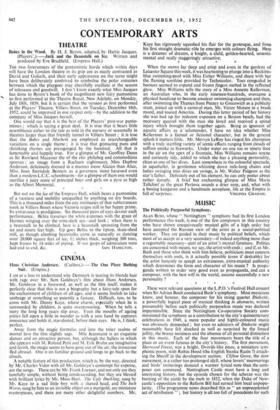CONTEMPORARY ARTS
THEATRE
THE two forerunners of the pantomimic horde which within days will have the London theatre in its grip are as nicely contrasted as David and Goliath, and their early appearance on the scene might have been deliberately contrived to symbolise the polar extremes between which the playgoer may cheerfully oscillate at the season of tolerance and goodwill. I don't know exactly what Miss Jacques has done to Byron's book of the magnificent new fairy pantomime as first performed at the Theatre Royal, New Adelphi, on Monday, July 18th, 1859, but it is certain that the version as first performed at the Players' Theatre, Villiers Street, on Tuesday, December 16th, 1952, could be improved in one respect only—by the addition to the company of Miss Jacques herself.
One would say that it is the best of the Players' post-war panto- mimes ; which is saying a great deal. It is true that it bears little resemblance either to the tale as told in the nursery or seasonally in theatres larger than that friendly tunnel in Villiers Street ; it is true that the Babes and Macbeth are employed as interchangeable variations on a single theme ; it is true that grimacing puns and shrinking rhymes are pressganged by the hundred. All that is lamentably and happily true. For a glimpse of Mr. Geoffrey Dunn as Sir Rowland Macassar (he of the chic philabeg and commodious sporran : an image from a Raeburn nightmare), Miss Daphne Anderson, deliciously dressed in a manner more Alician than Alice, Miss Joan Sterndale Bennett as a governess more harassed even than a modern-L.C.C. schoolmarm—for a glimpse of them one would sacrifice a juicy score of principal boys and girls on a pyre as high as the Albert Memorial.
* But not on the ice of the Empress Hall, which bears a pantomime of a vastness and mobility unequalled by anything on dry boards. This is a thousand miles from the coy intimacies of that subterranean nook in Villiers Street where Victoria reigns still in her happy prime. Its extravance is prodigious. Six thousand pairs of eyes devour each performance. Belita traverses the white expanses with the grace of Hermes winging over the wine-dark sea—and look ; when there is a beanstalk to be climbed, here is a beanstalk sprouting from the ice and ninety feet high. Up goes Belita to the tiptop, skate-shod still, as though climbing beanstalks came as naturally as dancing over 20,000 square feet of ice, 1 1 inches thick, weighing 300 tons, kept frozen by 14 miles of piping. If our gasps of admiration were


































 Previous page
Previous page